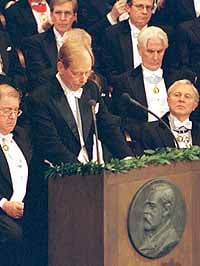Award ceremony speech
Presentation Speech by Professor Björn Roos of the Swedish Academy of Sciences, December 10, 1998.
Translation of the Swedish text.

Photo: Hans Mehlin,
Nobelprize.org
Your Majesties, Your Royal Highness, Ladies and Gentlemen,
Man is fantastic. Through his studies of nature, he has brought order to chaos. He has created a language, mathematics, which makes it possible to formulate his knowledge about nature in a small number of simple sentences. Not only do these sentences summarize in a concentrated manner our knowledge about nature and matter, they can also be used to make predictions. With the aid of computer simulations, we can make weather forecasts, calculate the structural integrity of bridges, the aerodynamical characteristics of airplanes, etc. Today, we celebrate the fact that mathematics has invaded chemistry, that by means of theoretical calculations we can predict a large variety of chemical phenomena. Professors Walter Kohn and John Pople have individually made fundamental contributions to this development.
An atom consists of a nucleus and electrons. The motion of the electrons is described by the laws of quantum mechanics. When these laws were formulated more than 70 years ago, researchers realized immediately that in them was contained the explanation of the chemical bond. It was realized that if the quantum mechanical equations could be solved, one would be able to explain how atoms are bound together to form molecules. It would be possible to explain why molecules look as they do, what their properties are, and how they react with each other to form new molecules. A theoretical description of all of chemistry was within reach.
To achieve all this was, however, not easy. The equations are complicated and in the beginning it was only possible to solve them for the simplest cases. The science of applying quantum mechanics to chemical phenomena therefore developed only slowly. It was only in the beginning of the 60s, when scientists could start using computers, that this development started to make rapid progress. John Pople was one of the scientists who understood at an early stage the potential that computers provided. He realized that if quantum chemistry was going to become important in chemistry, one had to develop methods that were effective and which could be used to compute interesting properties like the structure of molecules and binding energies for the chemical bonds. They also had to be easy to use for the general chemist, who could not be expected to be knowledgeable about all the subtle details of quantum chemistry. Pople was able to fulfill these conditions through a series of crucial innovations and improvements. He designed a new tool, which could be used to study molecules and compute their properties. This tool is a computer program called GAUSSIAN. It contains a theoretical model chemistry where quantum mechanical equations are solved through a series of more and more refined approximations. Pople’s methods are used today by thousands of scientists at universities and companies around the world, to study a large variety of problems in chemistry and biochemistry.
The methods that John Pople has developed, seek approximative solutions to quantum mechanical equations, where the fundamental quantity is the so called wave function, which describes the motion of all electrons. In two landmark articles from 1964 and 1965, Walter Kohn showed an alternative way in which quantum mechanical equations can be approximated. He showed that there is a one-to-one correspondence between the energy of a quantum mechanical system and its electron density, which is a function of three positional coordinates only and is, therefore, much easier to handle than the complicated wave function, which depend on the positions of all electrons. He also developed a method which made it possible to construct a set of equations, which could be used to determine the energy and electron density. This approach, called density functional theory, has developed during the last ten years into a versatile computational tool with many applications in chemistry. Due to its simplicity, it can be applied to larger molecules than the wave function based methods. Density functional theory has made it possible to study the mechanisms of chemical reactions in enzymes, for example when water is transformed into oxygen in photosynthesis.
Due to extraordinary circumstances, Professor Walter Kohn is not with us today. We hope to see him at the Prize Ceremony next year, instead.
Professor John Pople,
I have tried to describe in a few words how Professor Kohn’s and your work has led to a new revolution in chemistry. You have made fundamental contributions to the field of quantum chemistry, with the result that chemists and biochemists today have a new tool, which they can use to study chemical phenomena at a molecular level. This is an outstanding achievement. On behalf of the Royal Swedish Academy of Sciences, I wish to convey to you our warmest congratulations, and I now ask you to receive the Prize from the hands of His Majesty the King.
Nobel Prizes and laureates
Six prizes were awarded for achievements that have conferred the greatest benefit to humankind. The 12 laureates' work and discoveries range from proteins' structures and machine learning to fighting for a world free of nuclear weapons.
See them all presented here.
